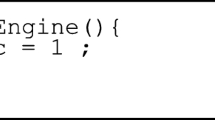Abstract
Commercial anti-virus scanners are generally signature based, that is, they scan for known patterns to determine whether a file is infected. To evade signature-based detection, virus writers have employed code obfuscation techniques to create metamorphic viruses. Metamorphic viruses change their internal structure from generation to generation, which can provide an effective defense against signature-based detection. To combat metamorphic viruses, detection tools based on statistical analysis have been studied. A tool that employs hidden Markov models (HMMs) was previously developed and the results are encouraging—it has been shown that metamorphic viruses created by a reasonably strong metamorphic engine can be detected using an HMM. In this paper, we explore whether there are any exploitable weaknesses in an HMM-based detection approach. We create a highly metamorphic virus-generating tool designed specifically to evade HMM-based detection. We then test our engine, showing that we can generate metamorphic copies that cannot be detected using existing HMM-based detection techniques.
Similar content being viewed by others
References
Attaluri S., McGhee S., Stamp M.: Profile hidden Markov models and metamorphic virus detection. J. Comput. Virol. 5(2), 151–169 (2009)
Aycock J.: Computer Viruses and Malware. Springer, Berlin (2006)
Bailey, M. et al.: Automated Classification and Analysis of Internet Malware, RAID 2007, LNCS 4637, pp. 178–197. Springer, Berlin (2007)
Caillat, B.A., Desnos, Erra, R.: BinThavro: Towards a Useful and Fast Tool for Goodware and Malware Analysis, ECIW (2010)
Cohen F.: Computer viruses: theory and experiments. Comput. Secur. 6(1), 22–35 (1987)
Daoud, E., Jebril, I.: Computer virus strategies and detection methods. Int. J. Open Problems Comput. Math. 1(2). (2008). http://www.emis.de/journals/IJOPCM/files/IJOPCM(vol.1.2.3.S.08).pdf
Desai, P.: Towards an undetectable computer virus. Master’s report, Departent of Computer Science, San Jose State University. (2008). http://www.cs.sjsu.edu/faculty/stamp/students/Desai_Priti.pdf
Durbin R. et al.: Biological Sequence Analysis: Probabilistic Models of Proteins and Nucleic Acids. Cambridge University Press, Cambridge (1999)
Filiol E., Josse S.: A statistical model for undecidable viral detection. J. Comput. Virol. 3(2), 65–74 (2007)
Gheorghescu, M.: An automated virus classification system. In: Virus Bulletin Conference (2005)
Gueguen, G., Filiol, E.: New threat grammars, IAWACS (2010)
IDA Pro. http://www.hex-rays.com/idapro/
Lin, D.: Hunting for undetectable metamorphic viruses. Master’s report, Department of Computer Science, San Jose State University (2010)
Mishra, P., Stamp, M.: Software uniqueness: how and why. In: Dey, P.P., Amin, M.N., Gatton, T.M. (eds.): Proceedings of Conference on Computer Science and its Applications. San Diego, July 2003. http://www.cs.sjsu.edu/~stamp/cv/papers/iccsaPuneet.doc
Rabiner, L.R.: A tutorial on hidden Markov models and selected applications in speech recognition. Proc. IEEE 77(2) (1989)
Stamp, M.: A revealing introduction to hidden Markov models, January 2004. http://www.cs.sjsu.edu/faculty/stamp/RUA/HMM.pdf
Stamp M.: Information Security: Principles and Practice. Wiley, New York (2005)
Szor, P., Ferrie, P.: Hunting for Metamorphic. Symantec Press, Cupertino. (2005). http://www.symantec.com/avcenter/reference/hunting.for.metamorphic.pdf
Venkatachalam, S.: Detecting undetectable computer viruses. Master’s report, Department of Computer Science, San Jose State University (2010). http://www.cs.sjsu.edu/faculty/stamp/students/venkatachalam_sujandharan.pdf
Walenstein, A., et al: The design space of metamorphic malware. In: Proceedings of the 2nd International Conference on Information Warfare, March 2007
Wong W., Stamp M.: Hunting for metamorphic engines. J. Comput. Virol. 2(3), 211–229 (2006)
Zbitskiy P.: Code mutation techniques by means of formal grammars and automatons. J. Comput. Virol. 5(3), 199–207 (2009)
Author information
Authors and Affiliations
Corresponding author
Rights and permissions
About this article
Cite this article
Lin, D., Stamp, M. Hunting for undetectable metamorphic viruses. J Comput Virol 7, 201–214 (2011). https://doi.org/10.1007/s11416-010-0148-y
Received:
Accepted:
Published:
Issue Date:
DOI: https://doi.org/10.1007/s11416-010-0148-y




